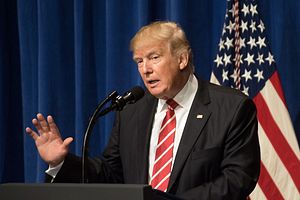On December 18, 2017, the Trump administration issued its National Security Strategy (NSS). Organized under four main principles — protect the homeland, promote American prosperity, preserve peace through strength, and advance American influence — the document provides a much-needed window into the administration’s vision of how it wants to shape U.S. engagement with the rest of the world. Referring to itself as “America First National Security Strategy,” the document is also the very first attempt to translate President Donald Trump’s campaign promise of “America First” into national strategic goals.
Although continuing to uphold (at least rhetorically) the importance of an all-of-government approach to pursue U.S. strategic goals, the NSS also clearly reflects the unique, “disruptive” nature of the Trump administration. It questions conventional wisdom, based on which past administrations, both Republicans and Democrats, have shaped their national strategies since the end of the Cold War, and criticizes it as “strategic complacency.” Such assumptions include past administrations’ aspirational approach to China and Iran — seeking to shape them into “responsible stakeholders” by engaging them — taking American military supremacy for granted, and the long-held belief in democratic peace. In this context, the NSS also honestly admits the complexity of national security challenges the United States faces.
This NSS is noteworthy in several ways. First, it explicitly singles out China and Russia as competitors that have emerged to “challenge American power, influence, and interests.” It also recognizes the strategic significance of space and cyber as new domains, and discuss efforts by adversaries to lower confidence in democratic institutions. Moreover, it spells out that U.S. adversaries and competitors often resort to “gray zone” activities that are coercive yet do not meet the threshold of military action or unlawful behavior.
For U.S. allies and partners in the Indo-Pacific region, the NSS suggests the strategic importance this region has for the United States. For instance, the NSS signals that this administration considers the Indo-Pacific region the most strategically important geographical area by referring to the region at the top of the section devoted to discussing the regional implications of its “America First National Security Strategy.” The Indo-Pacific appears ahead of the Middle East, which has dominated past U.S. administrations’ strategic attention. The affirmation of the U.S.leadership role in the Quad group of the United States, Australia, Japan, and India (while expecting Japan and India to take greater initiatives in the region) is also a stark contrast to the reference to Europe.
What is even more significant is the portrayal of China throughout the NSS. China has not only been referred to as a U.S. competitor that challenges America’s leadership in the world and the international order, but it also has been singled out for its aggressive investment and other economic activities in the areas outside the Indo-Pacific region, including Latin America and Africa. Moreover, the NSS talks extensively about how China has been successful in leveraging the most advanced technologies (which the NSS points out have often been acquired through cyber and other economic theft) not only to strengthen its military capabilities, but also to tighten restrictions against its people. Furthermore, the document discusses China’s relationship with Taiwan, which has been scarcely mentioned in the past National Security Strategies. The NSS has clearly set the tone for the administration’s approach vis-à-vis China — it will not shy away from being tough on a wide range of issues, including North Korea, maritime disputes in the region, and bilateral trade.
Of course, there are some questions remaining regarding how the principles that were set out will be translated into specific policies and initiatives. For example, although the NSS discusses boosting defense spending, whether the kind of robust increase that the administration hopes for can be achieved remains highly uncertain. Furthermore, although the NSS emphasizes energizing alliances and partnership around the world, whether such an approach to security issues on one hand while pursuing an “America First” trade policy primarily based on a bilateral approach on the other can achieve the effect that the administration hopes for is also uncertain.
Overall, however, the “America First National Security Strategy” laid out in the NSS is a welcome articulation of this administration’s commitment to ensure that the United States can still play a leading role on the international stage, even though some of the approaches it takes may be unconventional. For the countries in the Indo-Pacific region, which have been struggling to respond to increasing pressure from China both on security and economic issues, this is definitely a positive step for reaffirming U.S. commitment to peace and security in the region.

































